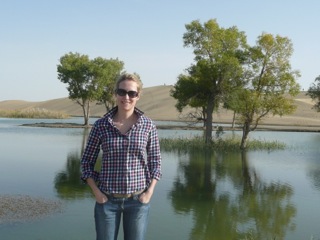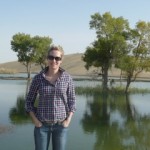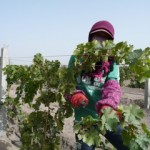
~
By Jim Boyce
This fall, Lillian Carter started her second China adventure when she headed to Xinjiang winery Wang Zhong, a six-hour drive south of capital city Urumqi, and followed up on the vintages she did at Pernod Ricard winery Helan Mountain in Ningxia in 2008 and 2009. Carter, who has worked at Oakridge Wines and at Domaine Chandon, both in the Yarra Valley, and at Orlando Wines in the Barossa Valley, answered a few questions about her new post.
This new project is in the equivalent of Australia’s outback. Where exactly is it? How do you get there?
Xinjiang Uygur Autonomous Region translates to ‘new frontier’. It’s an enormous and diverse region covering around one-sixth of China’s land mass and is a melting pot of cultures. The winery is in Yanqi County around 60 kilometers to the north of Kuerle, a city of half a million people an hour’s flight southwest of the capital, Urumqi. From Melbourne it can take up to four airport transits and two days to arrive. It’s remoteness means it has a special kind of rugged beauty, but it’s quite different to Australia’s outback.
How hard was it to make the decision to go to Xinjiang? What were the key reasons you decided to do it?
It wasn’t difficult at all. I have been interested in coming back to China since working for Pernod Ricard on the Helan Mountain project in Ningxia in 2008 and 2009. The Wang Zhong project is particularly exciting as it’s a completely new winery with owner-operated vineyards and Professor Li Demei as lead consultant.
What are you duties at the winery?
Daily vintage duties include tasting ferments in the morning and evening to determine the work schedule: things like red cap management and temperature regimes, pressing, racking, inoculations, and so on. I need to make sure everything happens logically and efficiently, which is more difficult than it sounds when an interpreter is involved in the communication process. Outside of vintage we are working on quite a few projects, such as establishing systems and processes, commissioning the bottling line and other new equipment, training and building up a strong team, implementing safety protocols -– there is a lot to do before the 2013 harvest.
What grape varieties are planted? How well are they faring?
The vineyard has been planted in stages to Cabernet Sauvignon, Merlot, Cabernet Franc and Chardonnay as well as smaller blocks of some interesting varieties. It’s the first harvest of three-year-old vines so a little too early to make comparisons. I’m particularly excited about the patch of Shiraz that was planted in 2011 and might be ready to harvest next year. I’ll keep you posted.
This has been a tough year, in terms of weather, for Ningxia and Shandong and some other wine region’s around the world. How has it been in Xinjiang? When did you start harvest?
It was warm and dry out here. In fact, the region has such low disease pressure that the viticulture practices are inherently organic, which means fungicides, pesticdes and herbicides are not used. Chardonnay was harvested in the third week of August and Cabernet Sauvignon at the very end of August. It’s always tricky to quote yield as this parameter is greatly affected by planting density and trellis design. The yield was restricted early in the season through bunch thinning that made sure the vines were balanced. Ultimately this is the most important parameter.
Given your experiences in Ningxia, what similarities and differences did you see in respect to Xinjiang when it comes to climate, soil, vineyard and winery skills, quality of the vineyards, and so on?
Like Ningxia, we also need to bury the vines for the winter but the growing season is much drier in southern Xinjiang. The soil is very sandy but I’d say Ningxia has a greater silt content owing to the Yellow River. The soils at the Wang Zhong winery are extremely rocky with a high pH. Water is drawn from underground and a drip irrigation is used which is great as it gives much better control than traditional flood irrigation methods. The region is enthusiastically embracing the wine industry and doing a good job of attracting skilled workers.
Speaking of Ningxia, in August you joined a tasting of 39 wines in Yinchuan as part of the Ningxia Wine Awards. What differences, if any, did you find between those wines and what you tasted in 2008 and 2009?
The wines selected for the tasting were surprising. They didn’t display as much of the under ripe, green pepper, herbaceous, slightly weedy notes I was expecting. Instead they showed pleasant, clean, ripe fruit character and palate weight. Its shows the region is maturing in a variety of ways.
What do you think about the potential there for varieties other than Cabernet Sauvignon and Cabernet Gernischt?
There are a swag of interesting varieties that could be better suited to Ningxia conditions than Cabernet Sauvignon and Cabernet Gernischt. Plus the flavor profile of the wines may be preferred by consumers. I know there are quite a few trials in place, and there are a host of climatic and bureaucratic complexities, but it’s pretty difficult to reach the commercialization stage when everyone is fixated on Cabernet Sauvignon. Also, I am looking forward to the day tier two and and tier three Chinese cities embrace white wine, but I’m not holding my breath.
Back to Xinjiang: What has been the biggest revelation from doing this project in Yanqi County?
The winery is under construction and won’t be complete until next year. Although all the internal wine-making equipment is in place, the building changes day by day. I was away from the winery for five days or so and arriving back it was staggering to see how much had been achieved.
What do you do for fun in this part of the world?
I came prepared with an e-reader and a tone of downloaded books. I have read more books in the last two months than in the last 10 years.
I’ve been very well taken care of and escorted to some breathtakingly beautiful sites around the area. Bosten Lake is the largest inland lake in China, covering 988 square kilometers, and the Talimu River is a vast inland river running through the desert.
Also see: Q&A with Lilian Carter on working at Helan Mountain winery
(Photos: Lilian Carter)

Sign up for the Grape Wall newsletter here. Follow Grape Wall on LinkedIn, Instagram, Facebook and Twitter. And see my sibling sites World Marselan Day, World Baijiu Day and Beijing Boyce. Grape Wall has no advertisers, so if you find the content useful, please help cover the costs via PayPal, WeChat or Alipay. Contact Grape Wall via grapewallofchina (at) gmail.com.




Leave a Reply
You must be logged in to post a comment.